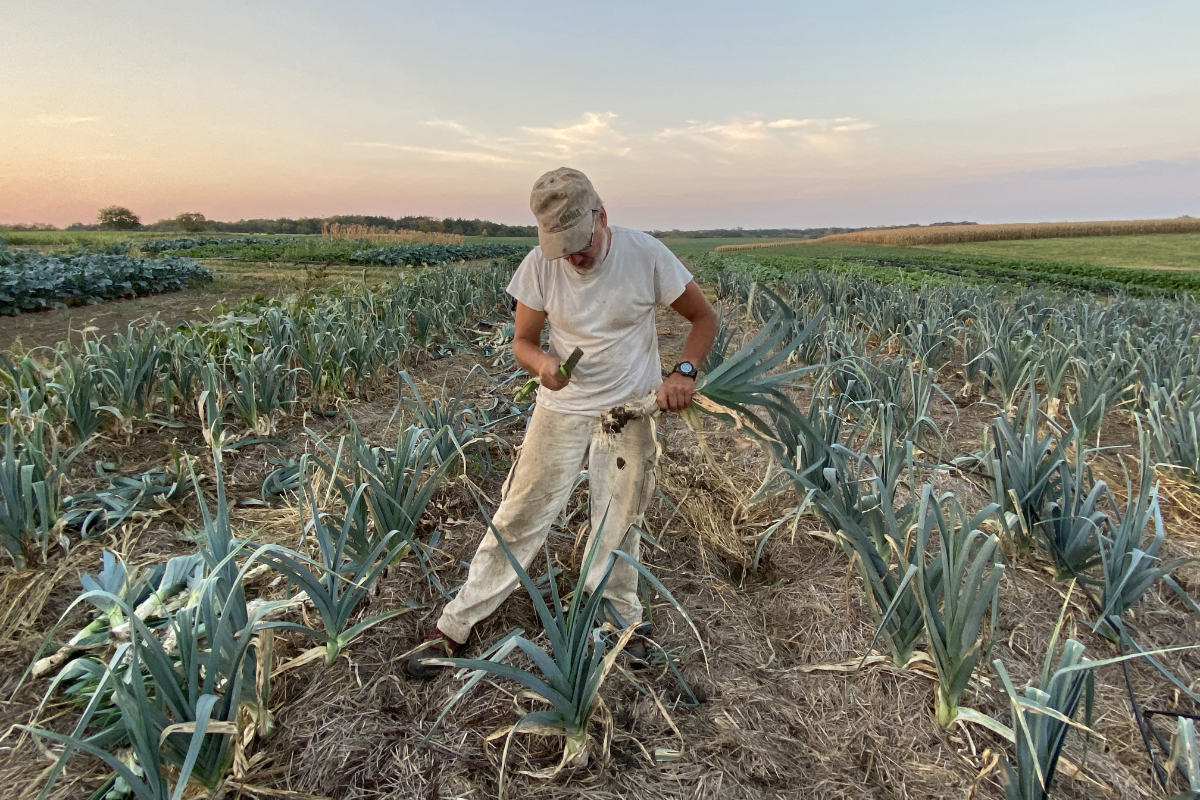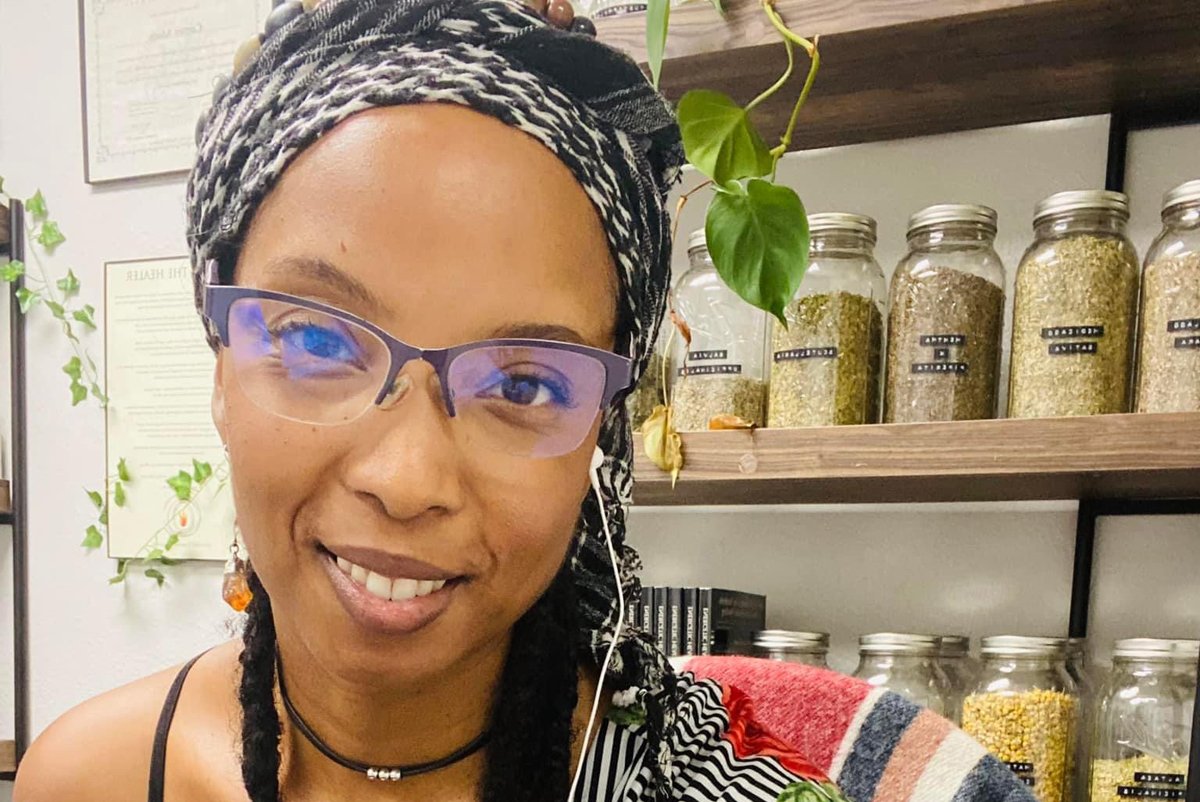For the past 25 years, Illinois organic farmer Henry Brockman has observed the impact of climate change on his farm. He’s now trying to save it, and its legacy.

For the past 25 years, Illinois organic farmer Henry Brockman has observed the impact of climate change on his farm. He’s now trying to save it, and its legacy.
December 6, 2021

Henry Brockman harvests leeks in the upper fields at Henry’s Farm in the heat of an October dusk.
In late September, Henry Brockman kneeled in the field, harvesting dried beans, their vines entwined over parched, dusty soil marked by fissures resembling lightening strands. He tugged the deep brown pods in a bushel basket alongside him beneath the early autumn sun in the rolling glacial hills of Congerville, Illinois. It had been two months since it had rained.
By late October, heavy rains arrived, but the month would historically come and go without a frost. Thin ice crystals would finally blanket Brockman’s operation, called Henry’s Farm, in the dark, crisp morning hours of November 2. As Thanksgiving nears, the fields will slip into a slumber.
“We have models that say by mid-century, there will be a 10 to 50 percent decrease in yields in Central Illinois. We really have to think ahead.”
Brockman, 57, a small compact man who says he always carries the aroma “of the last thing he harvested,” will not rest, however. After 28 years as an organic vegetable farmer, he says climate change has forced him to “start over” and spurred him to a state of constant experimentation as he works to keep his farm afloat and make it as resilient as possible for the coming generation.
Central Illinois is seeing weather and temperature extremes, as is the rest of the country. The climate there is changing that it has in the past, explains Don Wuebbles, director of climate science at the University of Illinois at Urbana-Champaign.
However, the region’s most significant changes are occurring at night. While the average temperature in the state has increased 1-2 degrees over the last century, the increase in overnight temperatures has exceeded 3 degrees in some parts of the state.
This part of the Corn Belt has seen a 10 percent increase in precipitation over the last century and the number of 2-inch rain days in Illinois has soared 40 percent in that time. As a result, the state has seen an increase in soil moisture. But, due to elevated rates of evaporation, the soil also tends to dry out faster, and longer dry spells have become more common.
All of these changes will likely make crops more susceptible to weeds, pests, and diseases, which will likely lower yields.
“We have models that say by mid-century, there will be a 10 to 50 percent decrease in yields in Central Illinois. We really have to think ahead,” Wuebbles warns.
Six years ago, Brockman took a year off farming and started doing just that. He penned an emotional 18-page letter to his children, Asa, Aozora, and Kazami. It was written as if from the future, to warn them about climate change. Dotting it are words such as “mourn,” “woe,” and “destruction” as well as “hope.”
In the scenario he imagined, it’s 2050, the farm is much smaller and mostly feeds the family. Brockman is in his 80s and corporate farms are able to produce much less food. Their synthetic, petroleum-dependent fertilizers, herbicides, insecticides, and fungicides are no longer widely available or affordable. Combines lay rusting in nearly barren fields. The climate in Congerville feels like Dallas. “The world is changed utterly,” the letter reads, “by human avarice and ignorance, and continues to change at a rate unprecedented in human history.”
Since returning to the farm, Brockman has been dedicating himself to preparing for the future. An award-winning documentary, Seasons of Change On Henry’s Farm, made before and during his leave, documented some of the challenges he faced. The changes since then, he said, are coming much more rapidly and more severe.
Brockman grew up with five siblings on a 1-acre farm surrounded by nearly 50 acres of woods. All the Brockmans write and have published books about farming and farm life. Three of them farm nearby and all four operations promote their work together online under the name Brockman Family Farms. Congerville is considered a mecca for organic farming due to its rich soil and rolling topography of ridges and plains formed by glaciers. The area is dotted with dozens of small-scale organic farms, some that belong to Apostolic church members who live off the land.
Outside Congerville, however, central Illinois is generally farmed by immense soy and corn operations that stretch, “a hundred miles in all directions,” says Brockman. When he crosses paths with the large-scale conventional farmers who have known him since high school, he says they often call out, “Hey Henry! How’s the garden growing?”
At 20 acres, he jokes, his farm “isn’t even large enough for them to drive a tractor onto.”
Although it’s small, Henry’s Farm is lush, producing 1 to 4 tons a week of more than 700 vegetable varieties. Brockman farms with intention and instructs his interns to “be present” and respect everything they harvest, while being mindful that it will be someone’s food. Plants, like any living thing, he contends, play their role in the cycle of life and death.
The farm feeds 345 families with its own community supported agriculture (CSA) program and others in the Chicago region. It sells most of what it grows to dedicated customers at a farmers’ market in Evanston, Illinois, whose customers he has fed for the length of his career. It’s nearly a seven-hour drive roundtrip.
For the last 25 years, Brockman has been taking meticulous notes in 10-year black journals and it’s there that he began unwittingly recording the mercurial weather and climate patterns he’s seeing more of now. Every day, he logs the weather, his plantings and harvests, the departure of some insects (the yellow-striped armyworm), and the new arrival of others, (the brown-striped armyworm). Around a decade ago, his own data revealed that things were starting to go terribly awry. Brockman dubbed it “global weirding.”
His farming season now lasts a month longer than it did when he started, extended two weeks earlier in the spring and concluding two weeks later in the fall. Springtime begins warmer but tends to be punctuated by unexpected bitter frosts that often wipe out newly planted seedlings. And rain? “Now floods can come in the spring, in July, September, and even in December,” he says. “Due to a flood in July last year, I had almost nothing at the market for a couple of weeks. When plants are underwater for more than 24 hours, their roots can’t breathe and they suffocate.”
Traditionally, Brockman planted heat-loving sweet potatoes in July. He now plants them in early spring and they sprout in May. His spring lettuce season has been cut short but now, due to warmer fall weather, he can plant lettuce again in the early fall and harvest it in November. “September is what August used to be, and when freezes come they come harder, ” Brockman says. “I’d usually be harvesting peppers the second week of July. Now, I’m still harvesting peppers in October.”
While he harvested peppers this fall, the owners of Cook Farm, a mere 20 miles south, flooded after three nearby tributaries rose and converged, leaving the Cooks to kayak across their fields. That week, between October 24 and 30, 4.5 inches of rain fell onto Henry’s Farm. “Somehow,” Brockman said, “we had no flooding.”
In an effort to adapt and anticipate the changes ahead, Brockman has made some radical changes to his farm. He cut production in half; he’s now farming only 10 of his 20 acres. A creek divides his two beloved bottomland fields, and in an effort to save the rich, 2,000-year-old soil on that land (and prepare for potential flooding), he moved his annual row crops to rented higher ground two years ago.
In their place, he’s planted an experimental perennial forest using a permaculture approach. There he’s growing currants and a variety of berries—gooseberries, honey berries, elderberries—as well as hazelnuts, pecans, pawpaws, and persimmons—in hopes that their more permanent roots will prevent the soil from washing away during heavy rains. Their more permanent roots will also keep more carbon in the soil. Among other experimental crops are paddy and dryland rice varieties.

Experimental plantings in the lower-field permaculture forest, with sorghum grasses in the background.
Behind the forest, Brockman is growing a field of sorghum-sudangrass, which will be used as straw mulch to keep the ground moist during dry spells. It will also add carbon to the soil as he cuts out tillage and grows more with cover crops in his rotations. A bit higher in the second bottomland field is a mix of perennial grasses and legumes, as well as potatoes and garlic.
Brockman is also trying to prepare for drought. Henry’s Farm rests on a deep aquifer, and the water beneath is trapped by the glaciers under hundreds of feet of clay. In other words, water there is a nonrenewable resource.
When he began farming, Brockman says he only needed to irrigate his crops in late July and early August. The rest of the year, rain was relatively predictable. In recent years, he has had to use drip irrigation beginning in May and the need often extends into the fall. This involves running yards of licorice-like hoses dotted with pinprick holes. They are laid across seeded ground to help the plants germinate.
It’s not clear whether one of Brockman’s children will takes over the farm, but the word retire isn’t in his current vocabulary, said his sister Terra. “Henry isn’t focused on passing the farm on to someone else, just on farming in the best ways possible for as long as possible,” she said.
His daughter, Aozora, is the only one currently working alongside her father. The author of two poetry chapbooks, she often describes life on the farm in her work. In Roots, she writes:
“In the hottest part of the day/we sit in the shade of the shed/in a circle of square bins/peeling the Russian Reds/each dirt-covered strip/revealing streaks the color of sky/in the last rumble before rain.”
This fall, it was so hot and dry on the farm that Brockman had to irrigate his young crops at night, using the water from his well. He would move his irrigation lines before dark and then get up in the middle of the night to move them again five hours later. Brockman, his fingertips stained with sap from the tomato plants he had trellised earlier in the day, manually laid out 40 lines, each 200 feet long. As he did so, he would jog back and forth in the dark to ensure it got done quickly—so the seeds would germinate. When he was done, he made his way home and back to bed, where he says he’s only rarely able to fall back asleep these days. As the year draws to a close, 2050 looms on the horizon.
All photos, except when noted, courtesy of Lori Rotenberk.

September 4, 2024
By paying top dollar for milk and sourcing within 15 miles of its creamery, Jasper Hill supports an entire community.
September 3, 2024

August 27, 2024

August 26, 2024

August 13, 2024

Like the story?
Join the conversation.